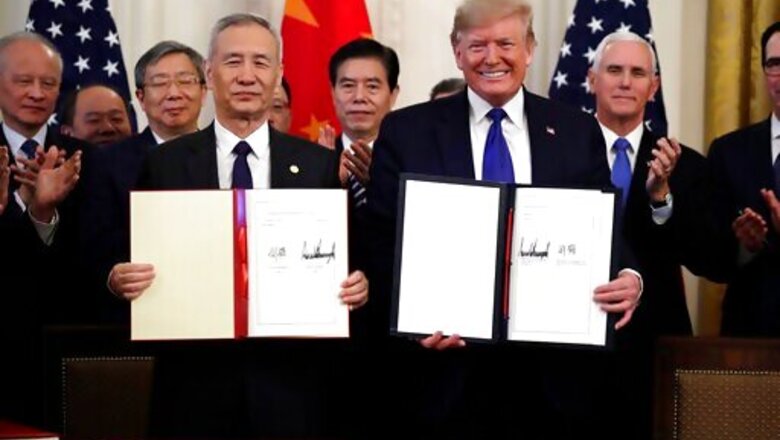
views
WASHINGTON: President Donald Trump said he would shake up American trade policy. That he did. From Beijing to Brussels to Mexico City, he waged war with trading partners on multiple fronts. Here’s a look at four tumultuous years of Trump trade policy:
TRADE WAR WITH CHINA
To rebalance Americas lopsided trade gap with China, Trump’s trade representative, Robert Lighthizer, targeted what critics called Beijings drive for technological supremacy by hacking trade secrets, forcing foreign companies to hand over technology and unfairly subsidizing Chinese companies. Once negotiations fizzled, the administration imposed tariffs on about $360 billion in Chinese imports in the biggest trade conflict since the 1930s.
Before Trump started his trade war, the average tariff on Chinese imports was 3.1%; now, it’s 19.3%. Beijing retaliated by jacking up taxes on U.S. products from an average 8% to 20.3%, according to calculations by Chad Bown of the Peterson Institute for International Economics.
The tariffs reduced Chinese imports and helped cut America’s trade deficit with China by 19% last year to its lowest point since 2013. In the first six months of 2020, the deficit has dropped an additional 21%.
In January, the two sides reached a so-called Phase 1 agreement that eased tensions but left major issues unresolved, including how China subsidizes its companies. Beijing agreed to stop forcing foreign companies to turn over technology and toughened intellectual property protection. The deal retains Trumps tariffs and lets the U.S. impose sanctions if it decides China has violated the terms of the deal.
China also agreed to buy huge amounts of U.S. products, including about $40 billion a year in farm goods a wildly ambitious goal that far exceeds the amount Beijing has bought in any year.
Joe Biden has said he would reverse Trumps go-it-alone policy and join with allies to confront China. But Lighthizer noted that President Barack Obama, for whom Biden served as vice president, had also reached out to allies to little effect. And tensions between the worlds two biggest economies, which have escalated since Trump blamed Beijing for unleashing the China virus,” will likely outlive the Trump administration.
FIGHTING AMONG FRIENDS
Far from courting allies, the administration smacked them with sanctions. In 2018, Trump declared tariffs on steel and aluminum. The intended target was China, which had flooded markets and forced down prices of the metals, thereby hurting U.S. producers. But Chinese steel and aluminum are already largely barred from the American market. So the tariffs instead hurt allies like Canada.
To justify the tariffs, Trump wheeled out a dusty weapon a section of the Trade Expansion Act of 1962 through which he declared the imports a threat to national security. Jim Mattis, defense secretary at the time, expressed misgivings, noting that the military needs only about 3% of U.S. production and so isnt dangerously reliant on imports. Mattis warned of the negative impact on our allies.
The metals tariffs did nothing to create jobs in the industries they were supposed to help. In fact, aluminum and steel producers cut 1,800 jobs from just before the tariffs took effect until February this year, before the pandemic seized the economy and cost even more jobs.
Trump has threatened to deploy national security tariffs again against imported cars and auto parts. But with businesses overwhelmingly opposed, he hasnt proceeded with what would certainly heighten tensions with the European Union.
NEGOTIATING NEW DEALS
Unhappy with existing trade deals, Trump sought new ones.
His administration forged a modest agreement with South Korea in 2018. And last year, it struck a deal with Japan that restored for U.S. farmers most of the access to the Japanese market they’d lost when Trump nixed the Trans-Pacific Partnership, an Obama administration pact with 11 Pacific Rim countries.
But a bigger Trump goal was replacing the North American Free Trade Agreement. That 1994 pact had erased most barriers among the United States, Mexico and Canada and accelerated regional trade. But it also led some U.S. manufacturers to move to Mexico, capitalize on low-wage labor and ship goods back into the United States, duty-free.
Trump called NAFTA a job killer. He threatened to abandon it if he couldnt get a revamped agreement, thereby raising the threat of a damaging disruption in trade. Lighthizer negotiated with Canada and Mexico before reaching a deal after Democrats secured changes, including stronger worker protections. Congress ratified the pact the U.S.-Mexico-Canada Agreement in January.
Critics dismissed USMCA as a modest update of NAFTA. But the USMCA does aim to regain U.S. manufacturing jobs. To qualify for duty-free benefits, automakers must obtain 75% of their production content from North America, up from 62.5% under NAFTA. And at least 40% of cars must originate in places where workers earn at least $16 an hour that is, the United States or Canada, not Mexico.
Besides returning manufacturing jobs to the United States, Lighthizer asserted, the trade deal will keep U.S. factories from moving South in the first place. I want to be judged not just by how much comes back but also by what doesnt continue to slide,” he said.
Still, the overall economic benefits could prove slight. The International Trade Commission has calculated that the USMCA would add $68 billion to growth and 176,000 jobs over six years blips in a $20 trillion economy with 142 million jobs.
Disclaimer: This post has been auto-published from an agency feed without any modifications to the text and has not been reviewed by an editor
Read all the Latest News and Breaking News here


















Comments
0 comment